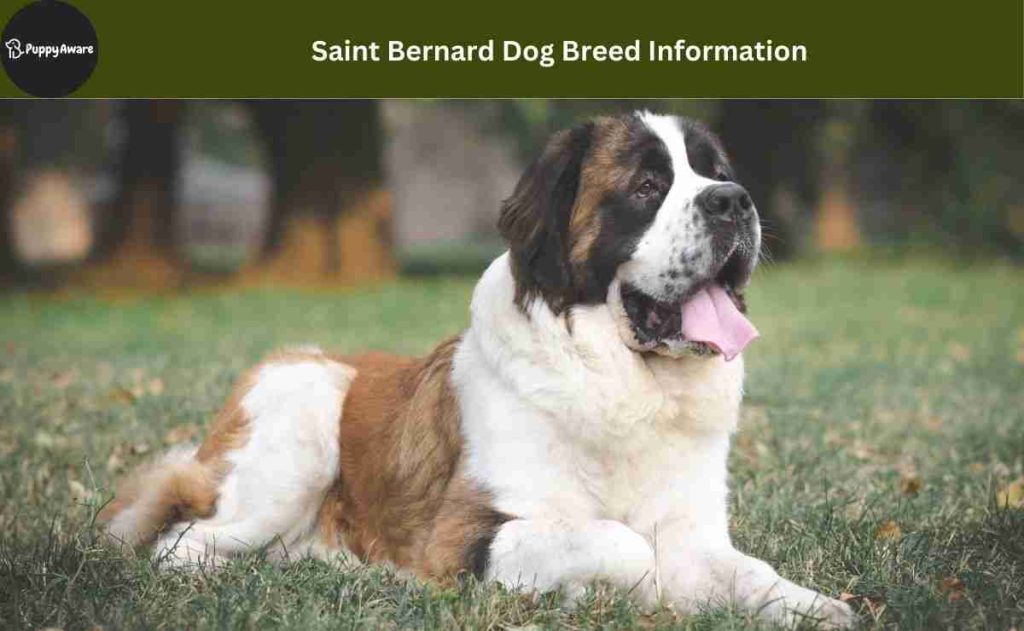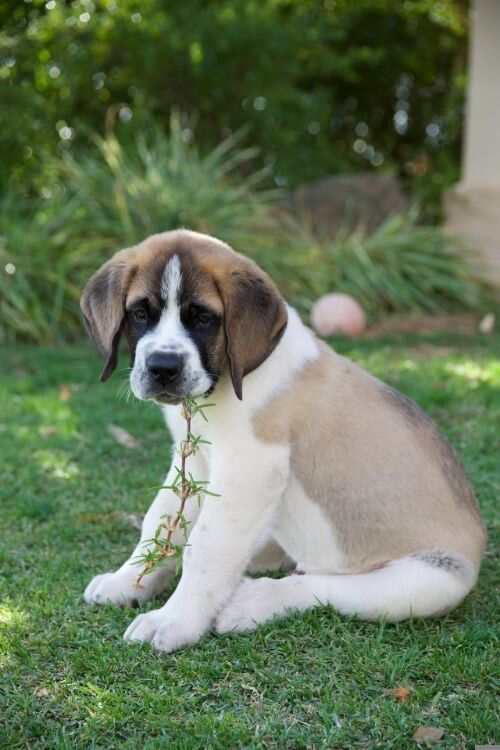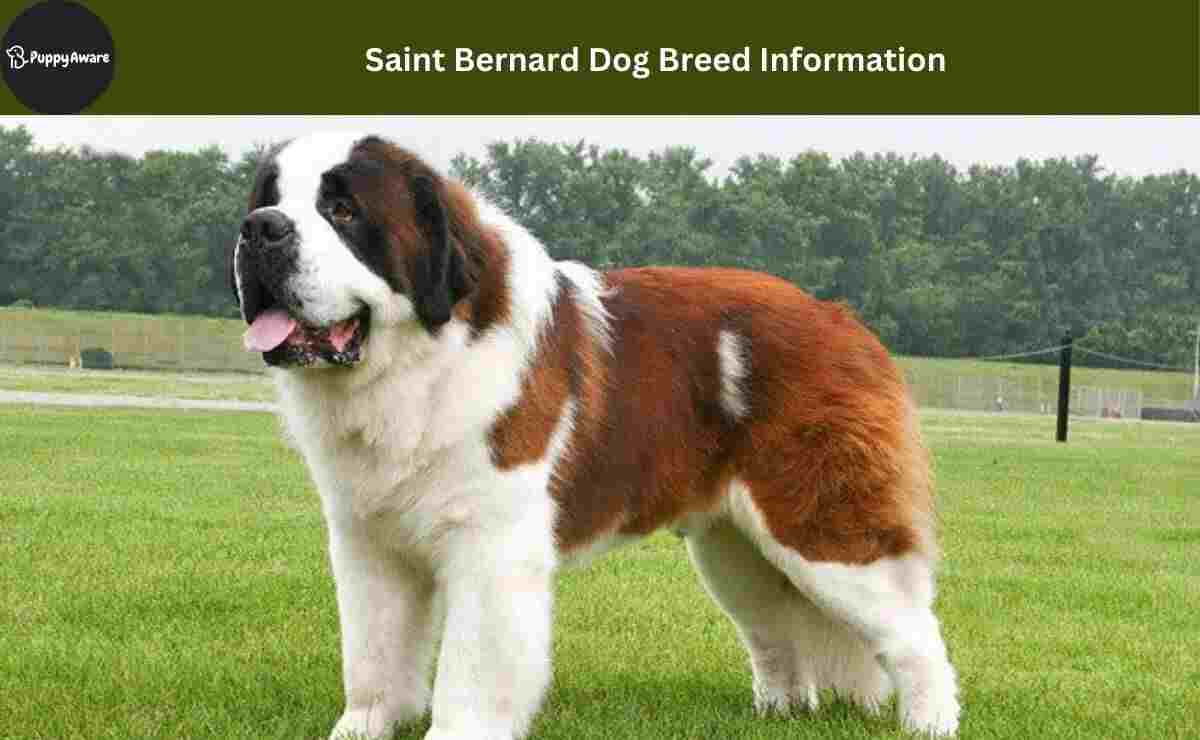The Saint Bernard stands as one of the most recognizable and beloved giant dog breeds in the world.
These gentle giants, with their distinctive appearance and heroic history, have captured hearts worldwide not just for their imposing size but for their exceptional temperament and incredible rescue abilities.
Breed Overview

| Characteristic | Detail |
|---|---|
| Origin | Switzerland (Swiss Alps) |
| Group | Working |
| Height | Females: 26-28 inches; Males: 28-30 inches |
| Weight | Females: 120-140 pounds; Males: 140-180 pounds |
| Life Expectancy | 8-10 years |
| Cost | $1,000-$3,000 (purebred from registered breeder) |
| Recognition | AKC, FCI, KC, CKC |
Physical Characteristics
The Saint Bernard boasts two distinct coat varieties:
Smooth Coat:
- Short, dense fur lying close to the body
- Thick undercoat for weather protection
- Smoother appearance overall
- Slightly easier maintenance
Rough Coat:
- Medium-length outer coat
- Dense undercoat
- Longer fur around neck (creating a mane)
- Feathering on legs and tail
Coat Colors and Markings:
- Primary combinations: White with red, brown, brindle, or mahogany
- Essential markings: White chest, feet, tail tip, noseband, and collar
- Facial features: Dark mask around eyes and ears
- Optional features: Black shading on body
Distinctive Physical Features
- Massive, well-proportioned head
- Deeply set, dark eyes with intelligent expression
- Medium-sized ears set high and carried close to cheeks
- Broad, powerful muzzle with well-developed flews
- Muscular neck with characteristic dewlap
- Deep chest and well-sprung ribs
- Strong, straight back and powerful legs
This breed’s impressive stature is complemented by a proportionate build that enables both strength and mobility, essential traits for their historical role as rescue dogs in the treacherous Alpine terrain.
Saint Bernard Dog Breed Information

Saint Bernard Dogs are one of the large dog breeds whom you may consider for your family as a friend and protector.
If you want to know more detailed information about the Saint Bernard Dog Breeds, read the below furnished comprehensive write up.
Temperament and Personality
The Saint Bernard’s temperament is as impressive as their size, characterized by a unique combination of gentle strength and protective instincts.
Key Personality Traits
| Trait | Rating (1-5) | Description |
|---|---|---|
| Affection Level | 5 | Extremely loving and devoted to family |
| Intelligence | 4 | Quick learners with good problem-solving abilities |
| Kid-Friendly | 5 | Exceptionally patient and gentle with children |
| Pet-Friendly | 4 | Generally good with other pets when properly socialized |
| Watchdog Ability | 4 | Natural protective instincts without aggression |
| Energy Level | 2 | Relatively calm and composed |
| Exercise Needs | 3 | Moderate daily exercise required |
| Trainability | 4 | Eager to please but can show independent thinking |
| Stranger-Friendly | 4 | Typically welcoming but alert to threats |
Mental Characteristics
Intelligence and Learning Style:
- Problem-solving capabilities, especially in rescue scenarios
- Strong memory for commands and routines
- Benefits from structured, consistent training
- May show stubborn streak during adolescence
- Excels in tasks requiring judgment and decision-making
Social Nature:
- Strong pack mentality with deep family bonds
- Natural empathy towards humans
- Excellent at reading human emotions
- Thrives on social interaction
- Can develop separation anxiety if left alone frequently
Emotional Sensitivity:
- Highly attuned to family members’ moods
- Responds well to positive reinforcement
- Can be sensitive to harsh corrections
- Shows remarkable patience with children
- Displays clear emotional intelligence in social situations
This combination of traits makes the Saint Bernard an exceptional family companion, though their size requires careful management and proper training from an early age.
History and Working Heritage

Ancient Origins and Development
The Saint Bernard’s history dates back to approximately 1000 CE, with their development closely tied to the Great St. Bernard Hospice in the Swiss Alps. Key historical milestones include:
| Period | Development |
|---|---|
| 1000-1100 CE | Establishment of the hospice by Bernard of Menthon |
| 1100-1300 CE | Early breeding programs by monastery monks |
| 1300-1700 CE | Refinement of rescue abilities |
| 1800-1900 CE | Recognition as a distinct breed |
| 1880s | First breed standard established |
| 1884 | AKC registration in America |
Rescue Legacy
The breed’s rescue work in the Alps spans centuries, with documented saves exceeding 2,000 lives. Notable achievements include:
- Development of specialized rescue techniques
- Ability to locate travelers buried under snow
- Enhanced sense of smell for tracking in severe weather
- Remarkable endurance in extreme conditions
- Capability to navigate through deep snow
Famous Saint Bernards
Barry (1800-1814):
- Credited with saving 40+ lives
- Most famous rescue dog in history
- Preserved and displayed at Natural History Museum in Berne
Other Notable Examples:
- Rutor: Saved 18 lives in one season (1858)
- Pluto: Known for leading rescue teams through storms
- Buck: Inspired Jack London’s “Call of the Wild”
Evolution of the Modern Breed
The Saint Bernard has undergone several changes since its original working days:
Physical Changes:
- Increased overall size
- Broader skull development
- Shorter muzzle than original working dogs
- Heavier bone structure
- More pronounced facial features
Working vs. Show Lines:
- Working lines maintain lighter frame
- Show lines emphasize massive build
- Both preserve essential temperament
- Varied emphasis on coat types
Care Requirements

Exercise and Activity Needs
Daily Exercise Requirements:
- 45-60 minutes of moderate activity
- Split into 2-3 sessions
- Focus on low-impact activities
- Avoid exercise in hot weather
- Mental stimulation essential
| Activity Type | Duration | Frequency | Notes |
|---|---|---|---|
| Walking | 20-30 mins | 2x daily | Keep pace moderate |
| Play Sessions | 15-20 mins | 1-2x daily | Interactive toys |
| Training | 10-15 mins | Daily | Mental exercise |
| Swimming | 15-20 mins | Weekly | Good for joints |
Grooming Requirements
Basic Grooming Schedule:
| Task | Frequency | Special Notes |
|---|---|---|
| Brushing | 2-3x weekly | Daily during shedding |
| Bathing | Every 6-8 weeks | Use gentle shampoo |
| Nail Trimming | Monthly | Check weekly |
| Ear Cleaning | Weekly | Check for infection |
| Teeth Brushing | Daily | Use dog toothpaste |
| Drool Wiping | Multiple times daily | Keep towels handy |
Living Environment
Space Requirements:
- Minimum yard size: 400-500 square feet
- Indoor space: Large, open areas
- Temperature control essential
- Non-slip flooring recommended
- Easy access to outdoor areas
Climate Considerations:
- Ideal temperature range: 40-75°F
- Avoid prolonged heat exposure
- Provide cooling options
- Indoor access during extreme weather
- Monitor for heat stress signs
Health and Training

Common Health Issues
| Condition | Risk Level | Prevention/Management |
|---|---|---|
| Hip Dysplasia | High | Regular screening, weight management |
| Bloat (GDV) | High | Multiple small meals, limited exercise after eating |
| Heart Disease | Moderate | Regular cardiac screenings |
| Eye Problems | Moderate | Annual eye exams |
| Degenerative Myelopathy | Moderate | Genetic testing |
| Osteosarcoma | Low-Moderate | Regular vet checks |
Training Guidelines
Early Training Focus (8-16 weeks):
- Basic commands
- Leash manners
- Bite inhibition
- Socialization
- Crate training
Advanced Training (4-18 months):
- Impulse control
- Advanced commands
- Public behavior
- Recall training
- Specialized skills
Nutrition Requirements
Daily Caloric Needs:
- Puppies: 2,200-3,000 calories
- Adult (active): 2,500-3,000 calories
- Senior: 1,800-2,200 calories
Feeding Schedule:
- Puppies: 3-4 meals daily
- Adults: 2-3 meals daily
- Seniors: 2 meals daily
Special Considerations
Owner Prerequisites:
- Physical strength for control
- Spacious living environment
- Financial preparedness
- Time for regular exercise
- Commitment to training
Cost Considerations (Annual):
- Food: $800-1,200
- Veterinary Care: $600-1,000
- Grooming: $400-600
- Insurance: $600-800
- Supplies: $200-400
Conclusion
This comprehensive guide provides potential and current Saint Bernard owners with the essential information needed for responsible ownership and optimal care of these magnificent dogs.
